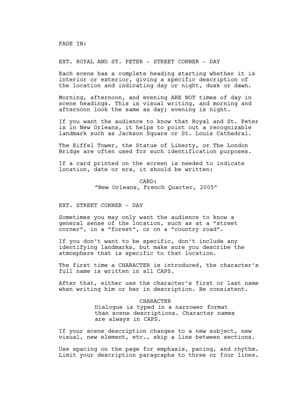
Just creating amazing characters in a memorable world who are struggling to obtain a goal(s) and writing the story with an original voice still isn’t enough to start a screenplay. A novel, maybe, but not a script. The prose writer has the freedom to use anything, go anywhere, use any tense, and explore any point of view. The screenwriter, however, is bound by form – not formula.
Screenplays have a very specific form, and if you ignore that form, it will not serve you, your story, or your audience, and it will definitely not help your screenplay. In fact, disregarding form will inevitably snuff out your script. And it will be a slow, painful death, essentially guiding the reader not to read.
So what’s the lesson learned? If you’re going to do something, do it right. Screenplay form is distinct and precise, and a script lacking this form almost always finds a home… right in the trash.
Screenwriting is essentially filmmaking on paper. It is a visual storytelling after all, and the screenwriter must write in PRESENT TENSE – only what the audience can SEE and HEAR. The screenwriter must always use the Three C’s: being CLEAR and CONCISE, yet still CREATIVE. Both in description and dialogue, creative brevity is the screenwriter’s steadfast ally and most powerful weapon.
The screenwriter does not have time to explore the story through long-winded, soul-searching monologues, and the script can’t be bogged down with the subtle intricacies of every little detail. There is no time for that, and the screenwriter must be concerned with time – Always! When writing a script, you only have between 90 and 120 minutes to tell your story. That’s not a lot of time, so script economy becomes something the screenwriter must strive for. If it does not illustrate character or moving the story forward, kill it.
In this section, you will learn how to be more economical with your scenes as well as to avoid common pitfalls such as directing on the page. You will see the importance of the white space, learning to steer away from “I” pages and block pages. And detailed templates for film features, TV dramas, and sitcoms are provided to help you demonstrate the practical use of the many different elements of proper screenplay form.
